Example Applications: Fish Passage at Big Noise Creek
Location: Big Noise Creek
is located in the North Coast basin. The creek is located in Clatsop County,
has headwaters in the Clatsop State Forest at an elevation of approximately
1,200 feet above sea level, flows North under Route 30 and joins Rock Creek
which eventually enters the Columbia River.
Description of Project: The
Oregon Department of Transportation (ODOT) is currently (2001-2002) using
an existing culvert for experimental retrofitting to improve juvenile fish
passage. The culvert allows Big Noise Creek to flow under Route 30. This
creek does not have a streamflow gage.
Objectives: For purposes of illustration, determine peak discharge
values for the stream to identify the culvert design flow that could be used
to size the culvert. Determine the range of culvert discharges and their
seasonal values that juvenile fish may encounter and use for testing
fish-passage design flow. For fish passage concerns, it is necessary that
the flows move through the culvert at appropriate velocities for juvenile
fish (e.g., 2 ft/s) and maintain a low-flow water depth (e.g., 8 in), based
on criteria set by the
Oregon Department of Fish and Wildlife (ODFW).
Procedure:
Step1: Review the Preliminary Estimations page to determine
a rough estimate of streamflow values for this region.
The preliminary estimates for the North Coast Basin will appear as follows:
|
NORTH COAST BASIN
|
|
Range for annual precipitation
(in)
|
80-180
|
| |
|
Annual discharge per unit area
(cfs/sq. mi)
|
4.98
|
| |
|
Monthly flow as a percentage
of mean annual flow (%)
|
|
OCT
|
NOV
|
DEC
|
JAN
|
FEB
|
MAR
|
APR
|
MAY
|
JUN
|
JUL
|
AUG
|
SEP
|
|
4
|
12
|
18
|
17
|
16
|
12
|
8
|
5
|
3
|
2
|
1
|
1
|
Note that the percentages do not quite add up to 100% (sum is 99%) due to
rounding of decimal values.
Step 2: Determine the drainage area of Big Noise Creek
from topographic maps (USGS topographic maps, Knappa and Cathlamet Quadrangles).
After delineating the boundary of the Big Noise Creek drainage area on topographic
maps, a planimeter was used to determine the drainage area (a GIS could also
be used for this purpose). The
drainage area for Big Noise Creek is approximately 1.8 square miles.
With this drainage area the annual discharge is expected to be approximately
9 cfs. The annual flow pattern shows low flows during the summer months
and high flows during the winter months. December, January and February
have the highest flows.
Step 3: Identify a nearby gage.
A review of the table of USGS gages for coastal Oregon shows three existing
gages that may be used for this project: Bear Creek, Tucca Creek, and Youngs
River. The table below lists information for these gages and also for the
Wilson River gage, which will be used later in the example. Bear Creek and
Tucca creek both have small drainage areas similar to the project stream. Beak
Creek and Youngs River are both located in Clatsop county and flow north
similar to the project stream.

Plots of mean annual flow vs. water year and normalized mean annual flow
vs. water year are useful for visualizing the period of record for each gage
and the general streamflow pattern for the period of record. Youngs River
has the longer period of record but the drainage area is substantially larger
than the project watershed. Plots of mean monthly flows and normalized mean
monthly flows illustrate the yearly streamflow pattern of each stream. All
three streams seem to have large flows in the winter months (Dec, Jan, Feb)
and have low flows in the summer months (July, Aug, and Sept). The plot
of mean monthly flows normalized by drainage area shows that for three out
of the four winter months (Nov, Dec, Feb) Tucca creek has a larger value
of MMQ/DA than Bear Creek. Bear Creek has the highest MMQ/DA for January
and also for the low flow months of July, August and September. The two
creeks, Bear Creek and Tucca Creek, may have slightly different yearly streamflow
patterns due to different local precipitation patterns in the regions where
they are located.





At this point, after examining the plots and comparing the stations with
site characteristics, the user may be able to select the nearby gage for
use of its streamflow data. An alternative, which is followed here for illustrative
purposes, is to conduct the hydrologic evaluations using more than one station. Although
requiring more work, this has the advantage of developing multiple estimates
for needed values, which may add confidence that the results are realistic
and not anomalous to a particular single selected gage.
Step 4: Perform a flood frequency analysis to determine
peak discharges for various return periods.
Peak flow analysis was done using data from all three streams. The results
of the flood frequency analysis are listed in the tables and chart that follow. The
flood discharge values calculated for each stream were scaled down to the
drainage area of Big Noise Creek using a ratio of drainage areas (DA of Big
Noise Creek/DA of nearby gage).
FLOOD FREQUENCY CALCULATIONS USING LOG-PERSON TYPE III ANALYSIS
Instantaneous Peaks




For this example, a 50-year flood will be used as the design discharge. Both
Youngs River and Bear Creek estimate the 50-year flood to be approximately
200 cfs. The Youngs River estimate is slightly lower than the estimate obtained
using data from the gage at Bear Creek. The drainage area of the Youngs
River gaging station is larger than that for the project site. Smaller watersheds
tend to exhibit different flood peak characteristics than larger ones. Other
considerations being equal, usually, time to peak is faster and peak flows
for the drainage area are larger. The Youngs River data may give lower peak
flow estimates due to the attenuation of flood peaks in the larger watershed
and may not provide a fully accurate representation of the smaller drainage
area of the project stream.
Tucca Creek estimates the largest discharge values for each return period. Tucca
creek has a slightly longer period of record compared to Bear Creek but Bear
Creek is more geographically similar to the project area. Tucca Creek has
its headwaters in the Coast Range at approximately 1,500 feet above sea
level and flows west to join the Nestucca River, which eventually enters
the Pacific Ocean. The precipitation patterns in this region, due to orographic
effects along the Coast Range, may be different than at the project site. Orographic
effects cause the rain clouds blowing east from the Pacific Ocean to release
their moisture on the western slopes of the Coast Range in manners that
are affected by elevation and rate of elevation change. Because the Coast
Range is the first mountain barrier encountered by air masses moving landward
from the Pacific, many of the coastal streams have elevated flows compared
to other regions of Oregon. The plot of mean monthly flow normalized by
drainage area illustrates that Tucca Creek has larger MMQ/DA than Bear Creek
for the winter (wet) months. Using Tucca Creek data may lead to overestimation
of peak flow values.
Thus, although Bear Creek has the smallest period of record, its location
and drainage area size may render it the best choice for estimating the streamflow
characteristics of Big Noise Creek. Bear Creek was selected as the appropriate
nearby gage to use for hydrologic assessment of Big Noise Creek. Culvert
design is usually based on peak flow analysis. Oregon Department of Transportation
(ODOT) guidelines will usually set the criteria that should be used and the
discharge associated
with the
criteria would be used for the design process. For example, if the culvert
needs to be designed to withstand a 50-year flood, then it must have the
capacity to handle a discharge of 212 cfs, based on the foregoing flood frequency
analysis.
Step 5: Perform Monthly Analysis for Big Noise Creek based on Bear Creek
Data
In addition to allowing passage for the stream, culverts also need to provide
passage for the fish inhabiting the stream. When performing hydrologic analysis
for fish passage evaluations, it is helpful to perform the analysis on a
monthly basis. All analyses for fish passage were done using streamflow
data from the gage at Bear Creek and scaling down the values to the drainage
area of Big Noise Creek. Bear Creek streamflow data were scaled using the
ratio of the drainage area of Big Noise Creek to the drainage area of Bear
Creek (1.8 sq mi. / 3.33 sq mi.).
- Discharge
vs. Month for various water years
- Shows
the year-to-year variability of the monthly streamflow pattern. For
each month, the past record shows a range of observed flows.
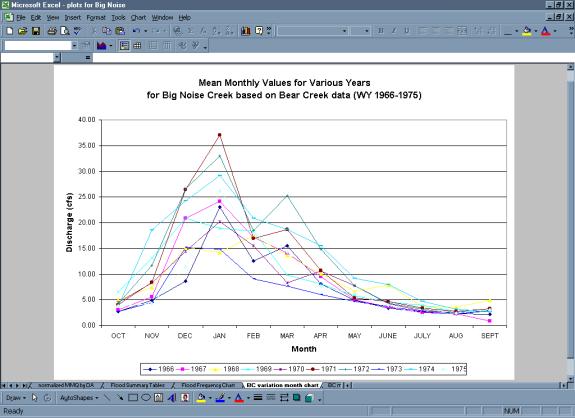
- Discharge
vs. Month of the water year
- Shows
the annual streamflow pattern based on averages for each month. This
simplifies the previous graph by eliminating variability through calculation
of the
mean values, by month.
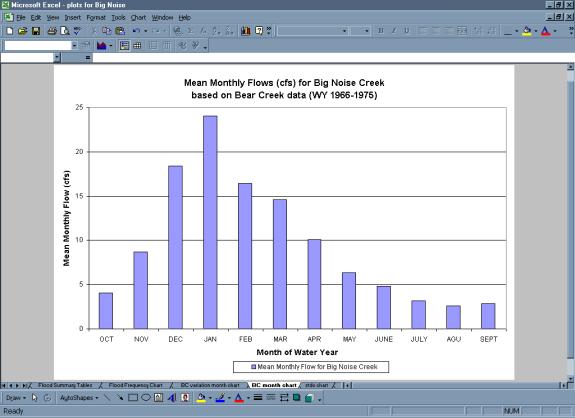
- Discharge
vs. Month of the water year with various statistics added (such as the
mean, the observed extremes and the standard deviation) to discern the
range of
flow values to be considered.
- Allows
the user to visualize the range of flows expected to occur and
the range for some percent (e.g., 68%) of the time to better know the
most
common
flows.

- Mean
Monthly Flows as a Percentage of Mean Annual Flow
- Shows
the wet and dry months of the year by the distance above and below
the mean annual flow value of 100%.

Step 6: Generate flow duration curves for each month that fish are present
and migrating in the creek.
It is not considered necessary or practical to design culverts to pass fish
at all times of year, particularly during brief periods at flood stage. Fish
generally are thought to take refuge when flows are severe and wait out the
passage of a flood. Hence, the hydraulic design of culverts for fish movement
includes selection of appropriate design flows from which the corresponding
flow characteristics can be derived by hydraulic analysis. For example,
the low flow depth design may be based on the 95% exceedence flow for the
migration period of the fish species of concern. Similarly, the high flow
design discharge could be the flow that is not exceeded more than 10% of
the time during the months of migration (for
current ODFW guidlines, click here). Flow
duration curves should be generated using daily flow values for each month
that fish
are
migrating
in the stream to determine the corresponding
95% and 10% exceedence flows. Fish passage criteria, set by fisheries agencies,
indicated that all of these flows must be able to pass through the conventional
culvert at a specified maximum velocity (e.g. 2 ft/s) and maintain a specified
minimum water depth (8 in) unless the culvert has been modified to improve
fish passage opportunities. The
largest of these values can be used in the design process to check if all
flows can meet the maximum velocity criteria and the lowest of these values
can used to check if all flows meet the minimum water depth criteria.
In Big Noise Creek, juvenile fish migrate upstream after the first fall
freshets from November to January. They migrate downstream in the late spring,
April to June. Also, winter adult Steelhead spawn from December to March
(Jeff McEnroe, 6/3/02). Hence, these are the months for which hydrologic
estimates are needed. Analysis results are shown in the following table. Based
on the results, the largest 10% exceedence probability flow occurs in January
and is equal to 42 cfs. The culvert and any retrofitting structures should
be designed to pass a flow of 42 cfs with a velocity of 2 ft/s if the passage
criteria for juvenile fish are to be met at high flows.
Furthermore, the low flows during the same period must be considered to
assure sufficient depth of water in the culvert for fish movement at winter
baseflow conditions. If fish are present between November and June, a flow
of 2.7 cfs would be suitable to use in analysis of minimum flows for fish
movement. To achieve adequate depths at these small flows in an existing
culvert, primarily designed to pass flood-peak flows, some form of retrofitting
of the culvert bottom may be required.
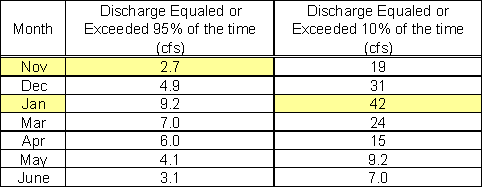
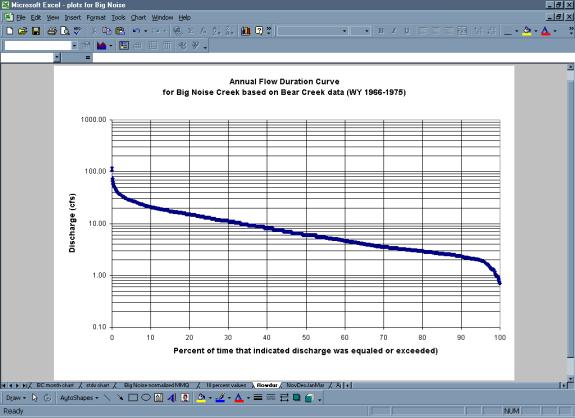
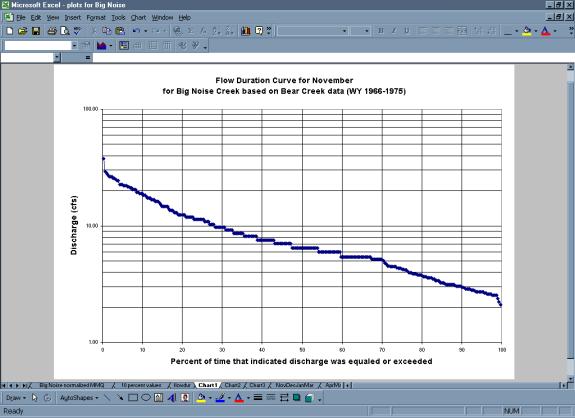
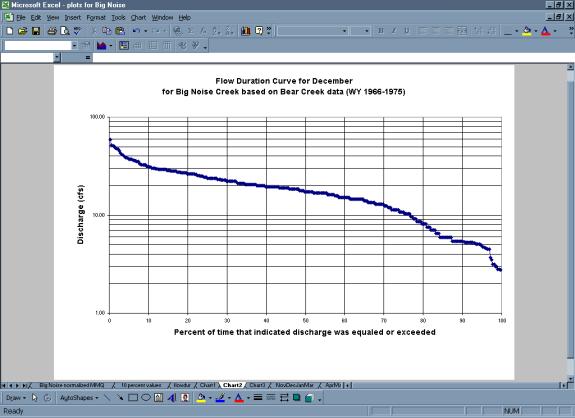
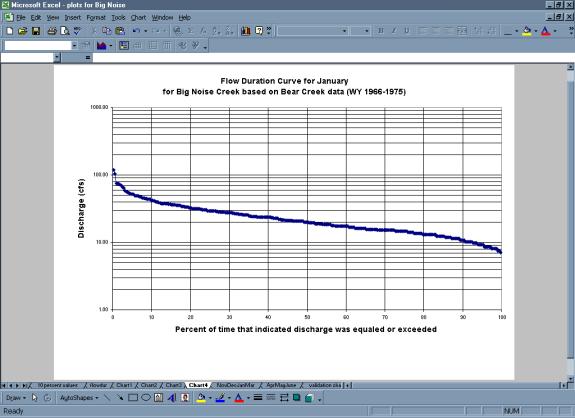

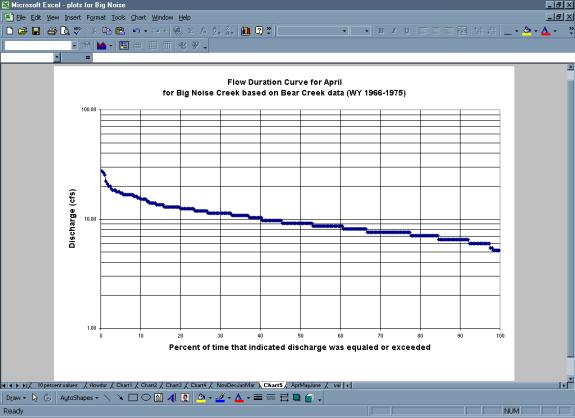

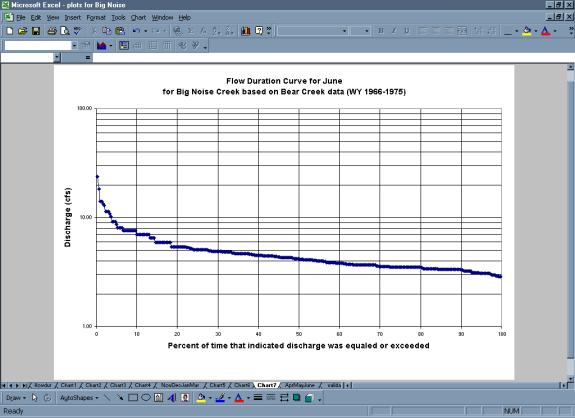
Step 7: Building confidence in flow estimates. How good are the data
and analyses?
One concern regarding the results of the hydrologic analysis for Big Noise
Creek is the length of the period of record for Bear Creek. The Bear Creek
gage has only 10 years of streamflow data. It may be useful to compare the
Bear Creek data to a data set for a longer period of record to determine
if the results generated using data from Bear Creek are representative of
long-term patterns for the region.
Wilson River has the longest period of record for the North Coast Basin. By
normalizing the mean annual discharge values for Bear Creek and Wilson River
(to compress the data to a more easily visualized comparative size) and plotting
Discharge/Unit Area vs. Water Year, the user can determine if the Bear Creek
and Wilson River data follow a similar pattern.
The following plot shows that the Bear Creek data does not occur in a particularly
dry cycle or wet cycle and they follow the same general pattern as Wilson
River. Wilson River has a larger average value for MAQ/DA than Bear Creek. This
larger value could be due to the orographic effect discussed earlier, as
the Wilson also has its headwaters in the Coast Range and flows west to
the Pacific Ocean. One could scale the Bear Creek values to the Wilson River
values by using the ratio of the MAQ/DA values of each stream.
(MAQ for Wilson River)*[(MAQ/DA for
Bear Creek)/MAQ/DA for Wilson)] =
MAQ for Bear Creek.
Another comparison that can be made is to determine the average MAQ/DA for
the Wilson River data for the concurrent water years (WY 1966-1975). A ratio
of the long-term average MAQ/DA to the short-term average MAQ/DA can be used
to obtain the long-term average MAQ/DA for Bear Creek.

However, since the data for Bear Creek do not occur in an extreme cycle
and the precipitation pattern in the Wilson River watershed may be slightly
different than in the Bear Creek watershed, it may be more appropriate to
use the flows estimated using only the Bear Creek data.

Step 8: Summary of Results
- Flood Frequency Analysis
- Used to design culvert capacity.
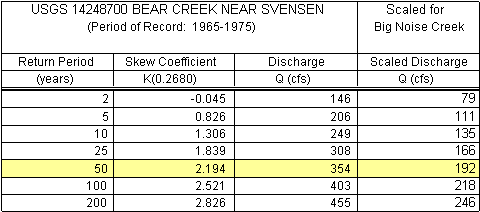
- Flow Duration Analysis
- Used to determine design flow for fish passage concerns.
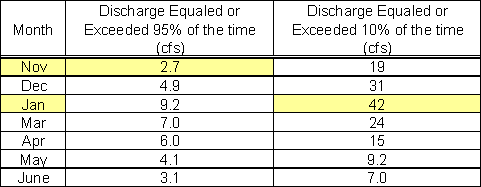
|


